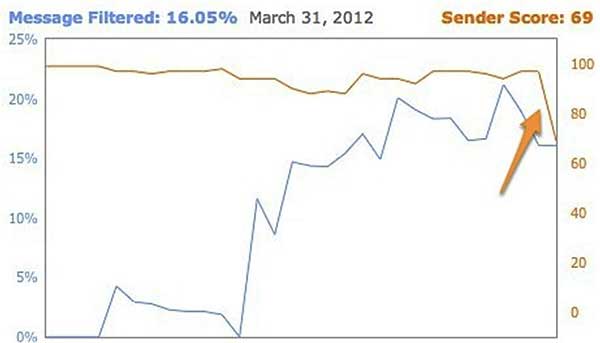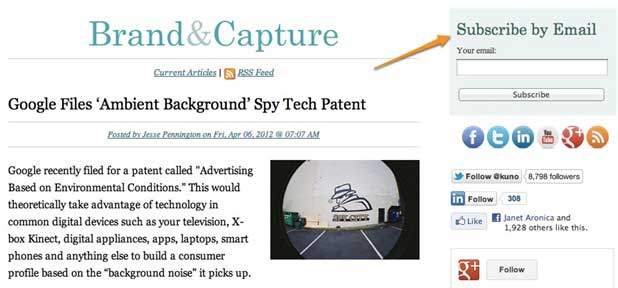Buying email lists is evil. Don't be evil.
Few things are as antithetical to good inbound marketing as purchasing a list of strangers' email addresses and blasting them with your latest campaign. You may get a short-term win, but emailing to a purchased list can be detrimental in the long run.
Beyond that, it's bad practice in general and causes frustration for the recipients, who haven't opted in to hear from you.
There are also two significant business risks associated with emailing to a purchased list:
1. It will damage your sender score
A company's sender score, which is tracked by Return Path, rates the reputation of every outgoing mail server IP address on a scale of 0-100. A company's sender score is determined by an algorithm that takes into account the ratio of undeliverable emails and spam reports for a company's sends.
Purchased lists are naturally higher in hard bounces and spam reports, and they can wreak havoc on your sender score. If your sender score drops, it severely limits your ability to have your future emails—even good, non-spammy ones—end up in recipients' inboxes.
That is what one bad email list can do to your sender score.

2. It could get you blacklisted
In addition to harming your sender score, purchased lists can contain spam traps or defunct email addresses that may land you on an email blacklist. B2B companies in particular need to be careful, because many corporate domains will use spam reporting services such as spamcop to identify and completely block emails from blacklisted senders.
Grow your opt-in list via inbound marketing
Inbound marketing is a strategy that focuses on building useful, interesting content to attract subscribers and prospective customers. The basic idea is this: Provide value, make it relevant, and the subscribers will come. The whole point of subscribing to something is because you're interested in it enough to want to be clued in to all future editions.
Tactically, possibly the best way to start with inbound marketing is to launch a blog and start creating good, search-friendly content. Blogs, social media, and organic search are the least expensive marketing channels; and, according to HubSpot's 2012 State of Inbound Marketing Report, inbound leads have a 13% higher close rate than traditional outbound leads.
To optimize your blog for subscriptions, make sure you have a clear call to action at the top of your blog. Kuno Creative https://www.kunocreative.com/ does a nice job of it:

In addition to driving subscriptions via your blog, incorporate email subscription options into any offers or registration events on your site.
Remember, when recipients subscribe to your email sends after reading a piece of content, they're expecting the same quality of content to be delivered to their inbox, so don't switch over to a heavy sales pitch as soon as you have their email addresses.
Give subscribers options
A good way to get website visitors to opt in to future email communications from you is to give them options about what type of subscription they'd like. Rarely will a subscriber be interested in every type of content you have to offer. Allow recipients to sign up by topic area or frequency.
For example, maybe I'd like to get occasional information about new products and announcements, but not the newsletter that you send out each week. Letting visitors narrow down their subscription type to just the information that matters to them will help them feel more comfortable giving you their email address and will result in a more engaged email list overall.
You have other ways to increase subscribers
- Run a co-marketing event: Join up with another company to co-host a webinar or a similar interesting event. Encourage the attendees to opt in to additional content and information from both companies.
- Investigate AdWords communication extensions: Google AdWords has been experimenting with enabling searchers to subscribe to a company's email list directly from the search results. Though it's too early to tell how effective those extensions are, if you're already investing in paid search ads you may want to give it a try. Search marketing company Wordstream does a nice job of explaining how communication extensions work and how to try them out.
- Provide clear benefits for subscribers: Make sure people who subscribe to your emails have an edge over those who don't. Provide them with sneak peeks of new products or offer them email-only discounts.
* * *
The bottom line is this: Email should provide value to subscribers, not interrupt them with a barrage of marketing messages. If a recipient doesn't remember your company or understand why he or she is getting your emails, there's a good chance you'll end up in the unread pile—or worse—on a blacklist.
Building an email list organically via opt-ins may take a little longer to reach the volume you want, but permission-based emails will always be more effective than those on purchased lists.
If you have any additional ideas for building an email list responsibly, I'd love it if you'd leave it in the comments below.




